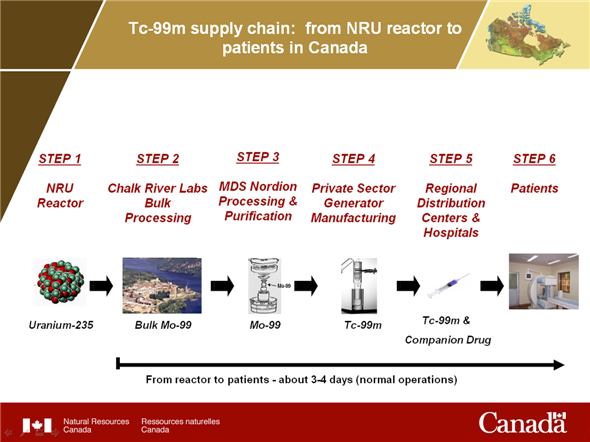ARCHIVED - Tc-99m supply chain: From the NRU reactor to patients in Canada
Information Archived on the Web
Information identified as archived on the Web is for reference, research or recordkeeping purposes. It has not been altered or updated after the date of archiving. Web pages that are archived on the Web are not subject to the Government of Canada Web Standards. As per the Communications Policy of the Government of Canada, you can request alternate formats. Please "contact us" to request a format other than those available.
The radioactive isotope technetium (Tc-99m) is used for a variety of medical diagnostic imaging procedures. Tc-99m is derived from molybdenum-99 (Mo-99), which is produced by a small number of research reactors around the world including the National Research Universal (NRU) reactor at Chalk River Laboratories in Ontario.
Supply Chain:
The supply chain for delivering Tc-99m to Canadians comprises a series of complex steps requiring cooperation and coordination among domestic and foreign organizations, both public and private. These steps are summarized below (see also the accompanying diagram):
-
In Canada, the NRU is the first step in the supply chain. The NRU irradiates small quantities of highly enriched uranium to produce Mo-99.
-
Mo-99 is extracted from the irradiated uranium and processed in bulk at a facility at Chalk River Laboratories.
-
The processed Mo-99 is shipped to MDS Nordion, a private sector company in Ottawa, for further processing and purification.
-
MDS Nordion exports the purified Mo-99 to private sector radiopharmaceutical companies — primarily in the U.S. — that manufacture Tc-99m generators. The generators are devices used to extract the Tc-99m derived from the purified Mo-99.
-
Radiopharmacies and hospitals across Canada purchase Tc-99m generators directly from distributors, which are Canadian subsidiaries of the U.S. radiopharmaceutical companies.
-
Central radiopharmacies and hospitals manage the supply of Tc-99m and companion drugs within their networks to meet patient care needs.
While Tc-99m derived from Mo-99 produced at the NRU has historically supplied a large portion of Canadian demand, Canada’s healthcare system also uses Tc-99m sourced from reactors in Europe and South Africa.

Time frame:
-
Mo-99 has a relatively short half-life (the time required for a quantity of radioactive material to decay to half of its initial amount) of 66 hours. Tc-99m has an even shorter half-life of approximately six hours.
-
Such short half-lives mean that these isotopes cannot be stockpiled for later use. In order to ensure continuous supply, Mo-99 and Tc-99m must be produced regularly and shipped within adequate time frames.
-
The various steps in the supply chain can take place at different locations and in different countries. Both the steps and the intervening transportation add time. The production process, from the start of uranium irradiation to the delivery of Tc-99m to patients, takes about 10 days.
Regulatory Requirements:
The importation and sale of radiopharmaceuticals are governed by Canada’s Food and Drugs Act, the Food and Drug Regulations, and the Nuclear Safety and Control Act.
Page details
- Date modified: